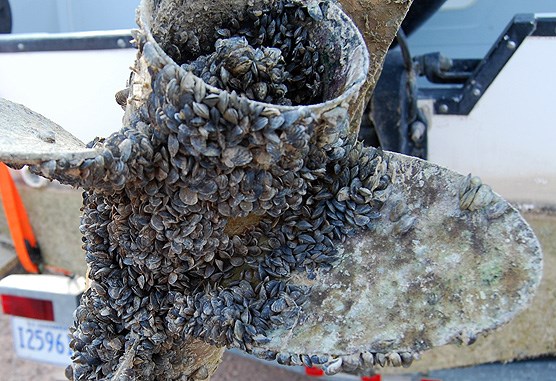
By Dylan Farrell
Casper Star-Tribune
Via- Wyoming News Exchange
CASPER — Yellowstone National Park will implement new measures this spring to combat the spread of aquatic invasive species in the park.
Beginning May 25, the park will require all sailboats and some complex motorized boats — those with inboard, inboard/outboard and inboard jet motors — to undergo a mandatory 30-day dry period before entering park waters.
In addition to the dry period, any vessels previously contaminated by mussels are also banned from the park.
Though the measure sounds extreme, a press release from Yellowstone Public Affairs says the park’s primary concerns regarding those watercraft aren’t just about mussels reproducing. Yellowstone staff regularly test park waters for mussel DNA, and those vessels could lead to false positives.
The new restrictions will exist in addition to previous watercraft regulations, including an outright ban on any ships with sealed internal ballast tanks or evidence of previous mussel residence, whether the mollusks appear live or dead.
Like many other places across the country, the park is on high alert to prevent zebra and quagga mussels from entering its waters. The park is at a higher risk this year than in the past due to the recent spread of mussels to Pactola Reservoir in South Dakota and the Snake River in Twin Falls, Idaho, according to the release.
In a Tuesday meeting, a Yellowstone representative said that the vast majority of visitors to the park come from neighboring states, which would explain park staff’s apparently recently elevated concern.
Why the fuss?
To those unfamiliar with zebra and quagga mussels, the park’s fears may seem overblown. After all, how much can one species of glorified seafood harm an ecosystem?
As it turns out, a lot.
The diversity of local mollusk species is devastated across North America where invasive mussels abound.
In the Great Lakes region — one of the first freshwater regions to be hit by the species, thanks to container shipping and ocean access through the Great Lakes/ Seaway System — local mollusk populations have decreased by more than 90%, as evidenced by a 1990 USGS study.
Zebra and quagga mussels also appear to follow a process of invasion, according to the University of California, Riverside’s Center for Invasive Species Research.
Zebras typically handle the initial wave and are then supplanted by quaggas.
Lake Michigan, as the CISR uses for example, was first invaded by zebra mussels. In 2000, 98.3% of mussels in the lake were zebras. By 2005, they had almost entirely been replaced by quaggas, which consisted of a whopping 97.7% of the local mussel population.
Aquatic Invasive Species Biologist Mike Canetta said there are dozens of native macroinvertebrates — an umbrella term that covers species including shellfish, mollusks and aquatic insects — that could be adversely affected by the introduction of zebra or quagga mussels.
Though he was hesitant to speculate on potential effects, he emphasized that zebra and quagga mussels are uniquely hazardous to ecosystems.
“Throughout the western United States, quagga and zebra mussels are the highest priority aquatic invasive species, and rightly so, because of their ability to impact ecosystems,” Canetta said.
When quaggas come, the zebras don’t just disappear, either; density of growth skyrockets.
Quagga mussels can grow as dense as 7,790 per square meter. That’s more than eight times the density of zebras, which partially explains the proportional shift.
That density is the primary driver for ecological and infrastructure concerns. Canetta said the density and sheer coverage that zebra and especially quagga mussels can achieve is part of what makes them uniquely difficult to manage — more so than other small invasive species already being managed by the park, like New Zealand mud snails.
The CISR said mussels often clog water intake structures and coat rocks, docks, buoys, boat hulls and anchors, which significantly limit recreational possibilities.
Should an introduction occur, Canetta said, the park would consider a broad range of measures to limit the spread that would affect recreational opportunities, including possibly a complete ban on outside watercraft.
On top of those human concerns, mussels also consume large volumes of plankton and act as water filters. Not much gets out of their mouths, meaning there won’t be many nutrients left for native species.
In addition to that, an invasion would significantly hamper the park’s existing conservation and invasive species management efforts.
Yellowstone staff have been working to manage existing invasive species while providing native ones opportunities to reproduce and regain population. That requires a delicate touch, and introducing a species as aggressive and all-encompassing as mussels could upend those efforts.
Yellowstone’s fears aren’t entirely self-centered, either.
Several major rivers — including the Snake and Gardner — originate in the park and feed into major national waterways like the Columbia and Missouri. An introduction could affect more than a dozen states.
While the latter river already has a presence of zebras and quaggas, the Columbia remains the last major river system in the U.S. untainted by the scourge as of 2023, according to the U.S. Army Corps of Engineers.
That doesn’t mean there haven’t been scares, though. The Snake River was recently found to have a quagga mussel presence near Twin Falls in 2023, which was one of Yellowstone’s cited concerns behind the new regulations.
To treat the infestation, crews pumped a molluscicide into the river that killed the desired invaders, but it also harmed a significant number of native species.
Given its conservation goals — and the efforts the park is making trying to keep cutthroat trout populations healthy — officials may be hesitant to employ such a drastic measure.
Canetta said he can’t speak to whether or not the park would consider that measure, but officials are holding rapid response exercises to ensure they’re ready to approach the issue if it arises.
Despite concerns, Wyoming has managed to stay free of zebra and quagga mussels for this long. Yellowstone conservationists hope they can keep it that way forever.




